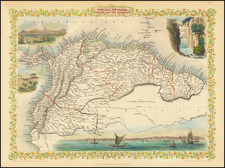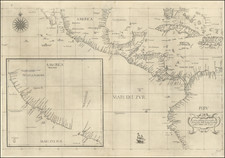Spanish Manuscript Chart of Cartagena in the Aftermath of the 1741 British Attack
Fine chart of Cartagena, one of the most strategically-important cities in the Americas, drawn shortly after the attack by Admiral Edward Vernon in 1741.
The chart includes rich hydrographic data, with numerous soundings in the surrounding waters, as well as yellow lines indicating the extent of shallows and sandbars.
The old town is situated at the foot of the fortified hill of San Lazaro, with the taller Cerro de la Popa rising behind it. La Popa houses its famous Augustinian monastery, pictured here, and is the highest point near the city. The monastery was founded in 1607, after Father Alonso de la Cruz Parades had a vison of the Virgin Mary, who told him to build a church on the hill closest to Cartagena.
La Popa is also featured in the relief drawing in the upper left corner, which shows the coastline and entrance to the bay as seen from the sea. This drawing has a key (in letters) running below it, while a more elaborate key in the upper right corner identifies fifty significant landmarks, settlements, and fortifications (with numbers) in and around Cartagena as shown on the chart below.
The key and scale cartouche are signed with, “Me fecit Franco, y Guzman.” Likely a military engineer, Franco y Guzman, whose identity is still under investigation, made this map in about 1745, in the aftermath of the attack by Admiral Vernon in the War of Jenkins’ Ear.
The date of the chart can be derived from the state of the fortifications shown on the chart. Item 41 in the key, Pastelillo, refers to San Sebastian del Pastelillo, a new fort built from 1741 to 1743 which replaced the previous Fort de Boqueron. It was planned by military engineer Juan Bautista MacEvan, with Captain Antonio de Arévalo, who oversaw much of Cartagena’s restoration. The fort is named Pastelillo here, indicating that it dates from at least 1743.
During this post-1741 period, engineers oversaw the restoration of the batteries at Chamba (Camba 34) and Santiago (San Tiago 32) and rebuilt Manzanillo (12). At Boca Chica (30) are a series of forts, including San Luis (31) and San Jose (29). Fortification of this area began in the seventeenth century, but the buildings were expanded and strengthened in the early-eighteenth century as part of efforts led by Juan de Herrera y Sotomayor, who also founded the city’s military academy in 1731. Perhaps this chart is by one of his students.
The fort is still called San Luis (31) here, although it had been leveled during Vernon’s attack. A new fort, San Fernando de Bocachica, would be raised from its foundations beginning in 1753. This suggests that this chart dates to the years between 1743 and 1753.
Cartagena de Indias
The coastal area where Cartagena now sits has been inhabited by Indigenous peoples since at least 4,000 BCE. For well over a thousand years, Carib-speaking peoples lived there, including in a village called Calamarí that was located in what is today the city’s downtown.
The Spanish made several faltering and failed efforts to settle along the southern coast of Central America in the first two decades of the sixteenth century. In January 1533, sailing on behalf of Joanna of Castile, Pedro de Heredia entered the Bay of Cartagena. He found the abandoned village of Calamarí and continued along the coast. He eventually landed and explored the region for three months, raiding Indigenous tombs in the search for gold. On June 1, he founded the city of Cartagena at Calamarí.
The settlement was granted city status in 1574. It quickly grew into an important port for the export of silver and the sale of enslaved peoples. The silver trade also made it an important port for pirates and buccaneers, with attacks in 1544, 1568, and 1569. A few months after the latter raid, the city burned. Twenty years later, in 1586, Francis Drake again burned many houses and the cathedral, leaving only when a ransom was paid.
In response to the piratical threat, the Spanish Crown ordered the city fortified, which included city walls and the narrowing of entrances to the bay at Boca Grande and near Manzanillo. Construction continued throughout the seventeenth century, ringing the city and port entrances with bastions, forts, defensive towers, and batteries. However, these defences did not mean the city was impregnable. In 1697, during the Nine Years’ War, French forces attacked the city by overwhelming the Castillo de San Luis at Bocachica. They reached as far as Getsemani before the governor surrendered and the invaders plundered the city.
The Battle of Cartagena de Indias, 1741
In many ways, the history of Cartagena is a history of fortification, attacks, and sieges. In 1739, resentment over Spanish raids of British ships in the Caribbean sparked the War of Jenkin’s Ear, which would widen into the larger War of Austrian Succession. The Commissioners of the British Admiralty planned a global strategy to harass Spanish trade and weaken its over-stretched navy and merchant marine.
Part of this strategy included an attack on Cartagena, led by Admiral Edward Vernon. Vernon’s forces included 124 ships, with 29 ships of the line, and nearly 28,000 men with a 12,000 strong landing force. However, many of the ships’ crews were already sick with tropical diseases by the time they arrived, requiring marines to man the ships. The Spanish had just under 3,000 regular troops.
The British squadron approached Bocachica in late March and attacked on April 5, 1741, taking Castillo de San Luis. Soon, they landed marines on Tierrabomba and Manzanillo and took Cerro de la Popa. The British had the high ground and practically surrounded the city.
However, on April 20, Vernon’s men failed to take San Felipe de Barajas, on Cerro San Lazaro, and suffered heavy losses. Illness had continued to wreak havoc as well, with large epidemics killing or laying low thousands. The state of his men and the arrival of the rainy season forced Vernon to withdraw. Interestingly, both sides claimed a victory, with the British celebrating the destruction of forts like San Luis, while the Spanish praised the defence of San Lazaro. There was considerable destruction, especially at Bocachica, necessitating the restoration efforts that are chronicled in the chart.










![[Galapagos] Carte de la Cote Occidentale D'Amerique Comprise Entre Le Golfe de Tehuantepec et le Golfe de Guayaquil (Amerique Centrale, Nlle Grenade, Equateru) . . . .1864](https://storage.googleapis.com/raremaps/img/small/57942.jpg)
![[ Peru, Ecuador and the Upper Amazon ] Maragnony sive Amazonum Fluminis Terrarum in Orbe Maximi quo ad Hispanicae Potestai subest Cursus cum Fluvys et Regionibus finitimis Utilitati Publicae probatissimis e Documentis accuratus novissime descriptus a quodam pereas provincias olim S.I. Missinario delineatus a Petro Parcar 1785](https://storage.googleapis.com/raremaps/img/small/89253.jpg)
![[ Charleston, Boston, New York, St. Augustine, Bahamas, etc ] Particular Draughts of some of the Principal Towns and Harbours belonging to the English French and Spanish in America and the West Indies.](https://storage.googleapis.com/raremaps/img/small/102804.jpg)

![[ Colombia ] Castilla D Oro](https://storage.googleapis.com/raremaps/img/small/99108.jpg)